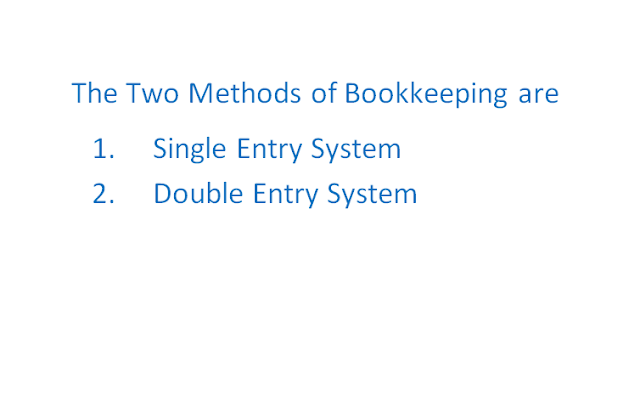Let us know, as to, What are the two methods (types) of bookkeeping?, which is a crucial part of our topic. We will also clear the two methods (types) involved in it. The two methods (types) are the Single entry system and the Double-entry system. These two methods are explained in simple steps below.
What is Bookkeeping?
Bookkeeping is the complete process of recording and classifying financial transactions in the books of accounts in a systematic and logical manner. With the help of proper it, a company or organisation is able to track its expenses, incomes, assets, liabilities, equity or owners capital. It helps in maintaining records of all the Journals, ledger accounts, subsidiary books and completing the tasks of payroll.
It helps in preparing and presenting the financial statements such as the Balance Sheet and Profit & Loss statement. This ultimately helps in knowing the financial performance and financial standings as well.
It also helps in maintaining accurate financial information which helps further in making decisions by management, investors, suppliers, creditors, debtors in knowing the creditworthiness and financial performance of the business entity. Hence a Bookkeeper plays a crucial role in any organisation to record business transactions and maintain financial records.
The Objectives of Bookkeeping are:
*The complete record of business transactions:
The main objective is the record of financial transactions in the books of accounts in a systematic and logical manner. This recording phase includes passing journal entries, posting them to ledger accounts and balancing the ledger accounts and classifying the accounts as asset, expense, liability, incomes, equity capital.
*To ascertain the financial effect on financial statements:
The secondary objective is to ascertain the financial effect of recorded transactions on financial statements. This helps to prepare reliable and accurate financial information in financial statements.

Methods of Bookkeeping:
There are generally the two most important methods. They are the Double Entry System and the Single Entry System. The double-entry system is concerned with the recording of transactions in dual aspect as debit and credit aspect. But under the single entry system, only one aspect of the transaction is recorded, either the receiving aspect or the giving aspect which is unscientific and not a systematic manner of recording the transactions. While the double-entry system is the complete, reliable and scientific method.for recording the business transactions.
1. Single Entry System
Under the Single Entry System, only one aspect of the transaction is recorded. Generally, each transaction has dual aspect such as the giving and receiving aspect. But, here, only one aspect either receiving or giving aspect is recorded in books of accounts.
This dual aspect concept such as the giving and receiving aspect is also termed as debit and credit. Under this system, only one aspect of the transactions is recorded. Here, this System is generally referred to as the accounting for incomplete records or incomplete system of recording.
For example, Cash paid to Supplier has two aspects. One aspect is Cash and another one is Supplier. But in this system, as explained earlier only one aspect is recorded. It means either Cash paid or Supplier name will be recorded in this system.
Very often, Sole trading concerns and small partnership businesses generally follow the Single Entry System. They maintain few records like Cashbook, Personal accounts like debtors or customers records and suppliers records. At the end of the year, these small business concerns want to know the financial performance and position. Here, generally, Accountants prepare income statement and statement of affairs to know the financial performance and financial standings.
Statement of Affairs is generally prepared to know the capital amount at the beginning and end of the year. Statement of Affairs is used to derive opening capital and closing capital amount. Capital amount is ascertained as the excess of assets over liabilities.
The objective of this system is to record the cash related transactions and information relating to debtors and suppliers. To determine the profit and loss and assets & liabilities position with the help of available information. by preparing income & expenditure account and statement of affairs. This system is useful for small business concerns where it is easy to maintain records with few records such as cashbook, debtors & suppliers account.
There are generally three types to the system. They are:
1. Pure single entry system:
In this system, only personal accounts are maintained. For example, debtors accounts, suppliers accounts or customers accounts. This would help to gather the information relating to customers and suppliers.
2. Simple single entry system:
In this system, personal accounts and cash book is also maintained. Cashbook is the main register for all transactions. Here cash book gives information relating to assets or liabilities and payments made to suppliers or cash received from customers.
3. Quasi single entry system:
In this system, personal accounts along with cash book and subsidiary books are maintained. Here personal accounts, cash book and subsidiary books are maintained.
2. Double Entry System:
Under the Double Entry System of Accounting, all the business transactions are recorded as Debit and Credit. These are the two terms used as Debit and Credit. It means the business transactions are divided into two aspects as Debit and Credit. For every Debit, there is corresponding Credit. The sum of the Debit amount is equal to the Credit amount. The debit is receiving aspect and credit is the giving aspect and vice versa
A business transaction is an event involving the exchange of goods and services between two parties. It is the agreement between the buyer and the seller to exchange the goods or services as measured in terms of money.
Debit and Credit are the two terms that are used under the double-entry system of book-keeping. The debit is an entry made on the left-hand side of an Account. Credit is an entry made on the right-hand side of an Account. Here Account is a Ledger Account that has T shape. Both these terms must have equal amounts in the double-entry accounting system.
The Accounting Equation will be as follow:
Assets = Liabilities + Owner's capital
Liabilities = Assets - capital
Owner's capital = Assets - Liabilities
The above Equation is the basis for the double-entry system of accounting. The balance sheet is also based on the above equation as "Assets are equal to the total of liabilities and owners capital." This helps in preparing systematic, scientific, reliable Financial Statements that include Profit&loss statement, Balance Sheet, Cash flow statement.
Golden Rules of Double Entry System of Accounting are:
Personal Account:
Debit - The Receiver
Credit - The Giver
Real Account:
Debit - If an Asset comes into the business entity
Credit - If Asset goes out of the business entity
Nominal Account:
Debit - All expenses, Losses
Credit - All Incomes, Gains
As per the Modern American approach, Debit if there is an increase in the value of Assets, Losses, Expense and Credit if there is an increase in the value of Liabilities, Capital, Incomes, Gains.
Asset Account: Debit if there is an increase in assets and credit if there is a decrease in assets
Liability Account: Credit if there is an increase in liability and debit if there is a decrease in liability
Expense Account: Debit if there is an increase in expense and credit if there is a decrease in expense
Revenue Account: Credit if there is an increase in revenue and debit if there is a decrease in revenue
Capital Account: Credit if there is an increase in Capital and debit if there is a decrease in Capital
Conclusion
Thus we can clear, as to, what are the two methods (types) of bookkeeping? As explained above, the two methods would include the Single entry system and the Double entry system. Both systems are useful and the business concerns may adopt any of the two methods depending on the size, complexity, volume of transactions involved in the business.
Related blogs:
What is Journal? Its features, types, Objectives and uses
What are Ledgers?
What is Trial Balance?
What are Financial Statements? Its features, types, uses
What is Income Statement (Profit and loss a/c)?
What is Balance Sheet (Position Statement)?
What is Cash Flow Statement?
What is Bookkeeping? Its features, objectives, uses?
What are Subsidiary Books? Its features, types, objectives, uses
What is Single Entry System? Its features, types, objectives, uses
What is Double Entry System? Its features, objectives, uses



Post a Comment
if you have queries let me know and mail me at syednissaruddin99@gmail.com